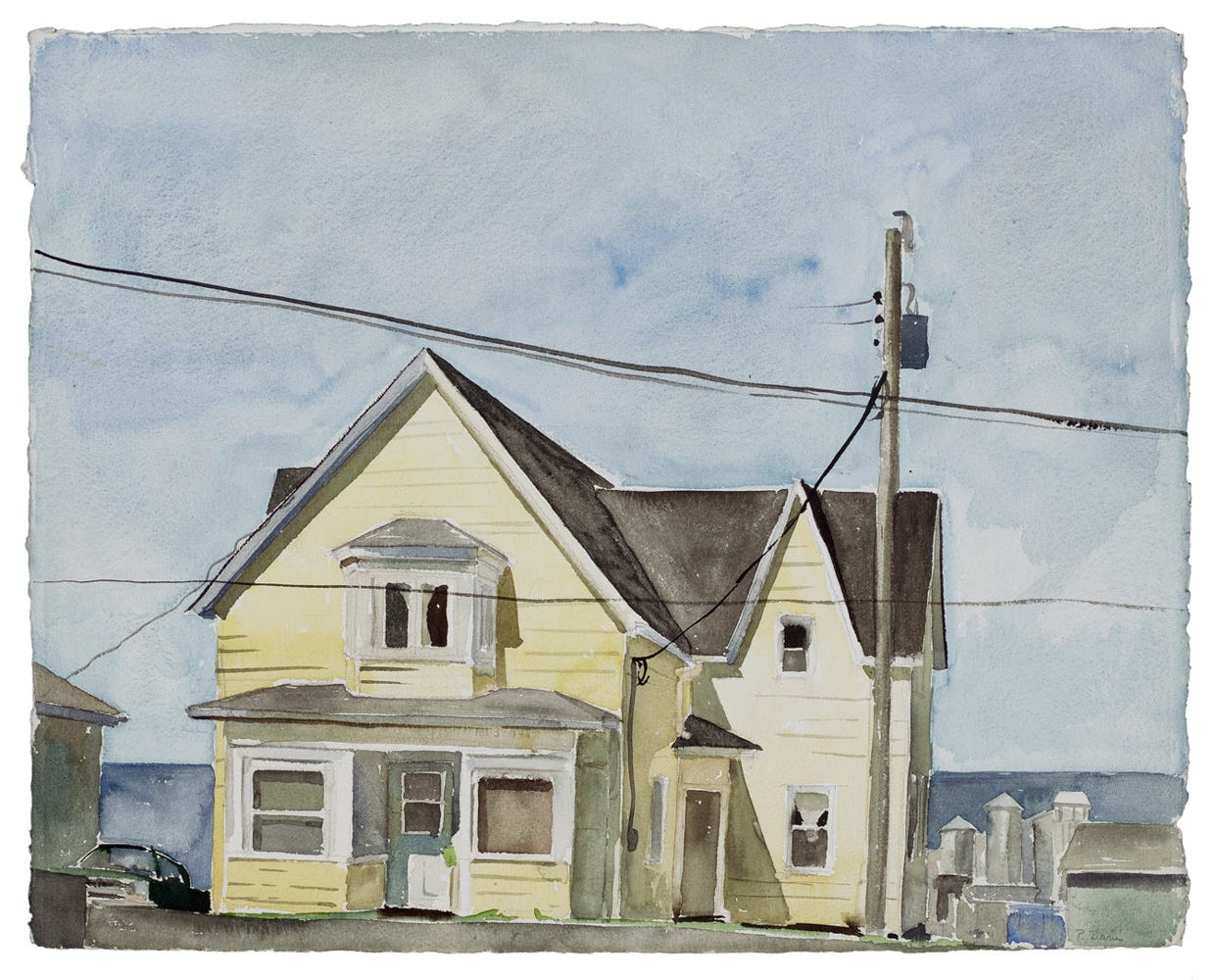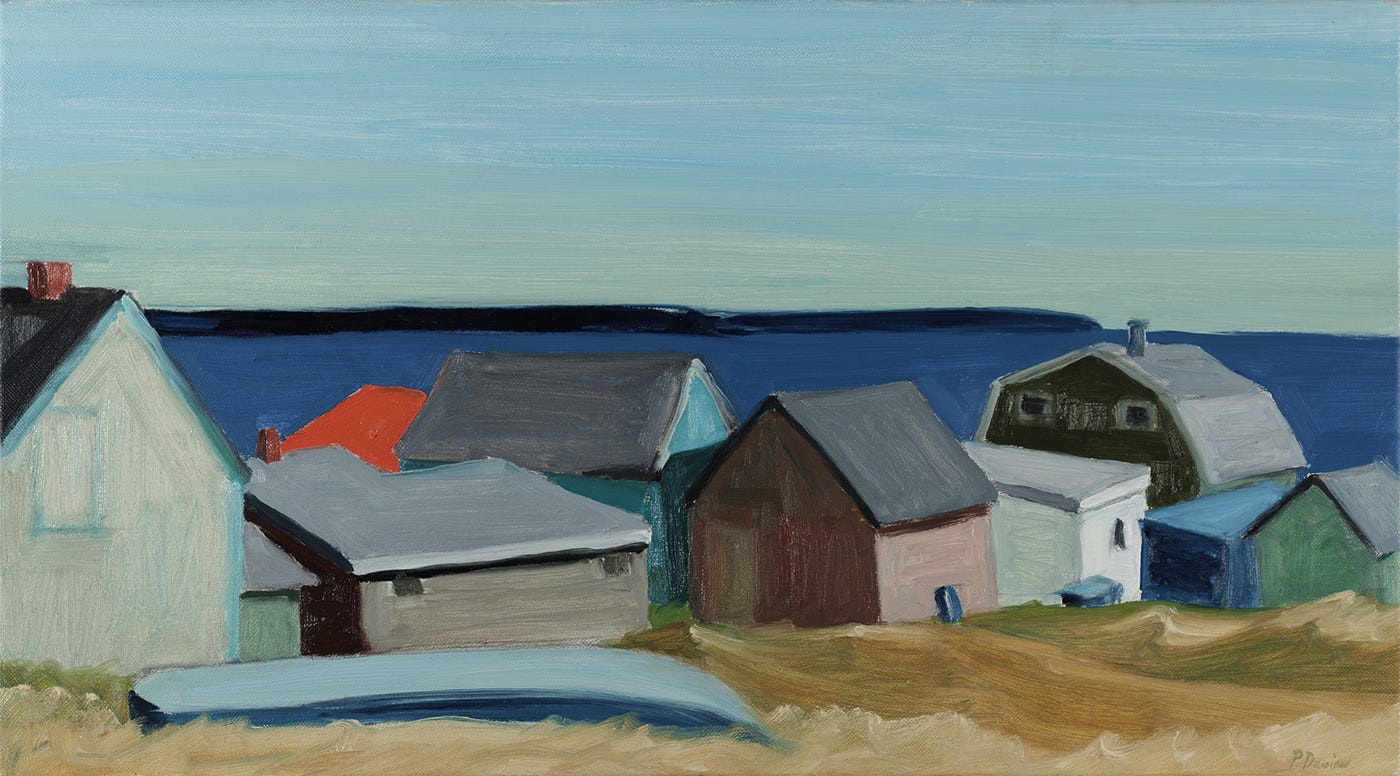Peter Devine
Painting What is Simply There
Peter Devine: Tattoo House, Nova Scotia
This essay about the New England and Nova Scotia coastal painter Peter Devine was written in 2019. Sadly Peter recently passed away in late June of 2024 at age seventy-seven.
THERE IS A QUOTE attributed to Chuck Close, which for many years struck me as an articulation of the guiding mindset of the contemporary art market. It goes something like this: “If it looks like art, it’s probably somebody else’s art”. This statement can be read in a variety of ways. But coming from Close — whose Brobdingnagian photo-realistic headshots loomed in the New York galleries in the late 1960s and early ’70s just as the Modernist revolution was finally exhausting its potentials — it felt like an industry rubric for winning critical attention and market share. What Chuck seemed to be saying (and mainly to other hungry young up-and-comers like himself) was: “look guys, nobody is gonna pay attention to you if you make anything that looks remotely like the old stuff. If you want to make something really catchy, something ‘important’, it better be different from anything anybody has ever seen before!”
Thinking of art, and especially of painting, as an act whose justification is contingent on its capacity for total novelty contradicts thousands of years of practice built on art historical reflection, re-interpretation and re-use. A skilled, historically astute painter cannot look at Manet without also seeing both the hand and spirit of Goya, as well as those of Valazquez, Hals or Rembrandt — not to mention the figurative compositions of Georgione or Raphael. Perhaps it was felt by Close and others in his generation that overt references to such a long line of precedents was fundamentally at odds with modern art’s mission to reflect the present moment and its most immediate experience, or to forbid any entry of the potentially corrupting influences of pre-digested idioms into the lifeblood of the NOW. If that was the case, the strategy succeeded, at least insofar as Close’s early work, along with that of many of his contemporaries from that time, is as firmly fixed to its fleeting era as a fly trapped in amber, where Manet — arguably one of the most provocative innovators of his day — can yet be seen within an historical continuum which stretches back for centuries. Curiously, the historical depth of Manet’s pictures also makes them more accessible in the present, by widening the scope of his vision out to something more universal than a fixed and fashionable cultural moment.
There is, however, a way in which Close got it exactly right, and to be fair to him, one should allow that his meaning may have been more nuanced than a mere formula for winning recognition in the art world. Throughout the Modernist age, we can find a long procession of painters who made completely innovative work, while yet reaching back, as Manet did, into painting’s history: Pierre Bonnard, Andre Derain, Giorgio Morandi, Fairfield Porter, Alice Neel and Jane Freilicher are a handful of examples in that line, though there are also many others. These painters are not the authors of titanic, epoch-defining statements. They are the quieter searchers who pursued unique, personal visions that were certainly innovative, yet also often at odds with the reigning zeitgeist. Bonnard’s liquid, light-filled interiors and windows, which were made at the height of Cubism’s more seemingly robust breakthroughs, felt at the time like a throwback to Impressionism. But today, as some of Picasso’s most iconic innovations have begun to feel jaded, bombastic, drenched in a self-conscious male machismo that today’s painters have long since abandoned, he begins to look a bit old fashioned, where Bonnard grows ever more Modern to our technologically fragmented eyes and our less explicitly gendered sensibilities.
I first saw Peter Devine’s paintings in 1977, when I began taking classes with him at my high school in Vermont. They were unexciting, even a little bit uncomfortable to my adolescent eye, which was steeped at the time in the facile and picturesque confections of illustrators like NC Wyeth, J.C. Leyendecker and Maxfield Parrish — or else dazzled by the painterly virtuosity of John Singer Sargent and the crisp perfections of Johannes Vermeer.
A painter in those days of interiors and still lives, nude and clothed figures and the occasional landscape, Peter was a realist in a period that had still not fully shaken off the idea that paintings had to be abstract in order to be taken seriously. The result, given his prior Modernist training, was that he made a formal abstraction of observed reality that was scrupulously faithful to some un-romanticized thing-ness which he seemed to be seeking in his carefully mundane subjects. His pictures were also analytically distant from any overtly emotional interpretation. By then, the Pop artists had already challenged the high-minded aspirations of pure abstraction, as did photorealists like Close and Estes; so a return to representation was already in the air. But Peter’s work didn’t fit into any of the clearly defined camps of the moment. Like Bonnard had been in the Cubist age, he seemed to be looking back at something in the recent past, but (at least to my immature eye) not making things that looked the way that art was supposed to look. “Your Paintings are really drab!” I complained to him at one point. “Yes Chris! That’s exactly what I want! I’m going for full drabness!!” he replied.
It is only in looking back now that I can see how Peter was in a sense transposing the formal ideals of Modernist abstraction — it’s abandonment of illusionistic narrative in favor of a near Platonic ideal of the purely material — onto the observed world. His perfection was not, however, that of either the elegantly rendered motifs of traditional representation, nor the bravura gestures of the action painters, but a studiously reduced, sometimes even awkward imperfection in the un-adorned truth of the ordinary.
As the years went by, the intellectual coolness of Peter’s compositions gradually shifted towards more intentionally poetic and playful interpretations, particularly in the landscape and maritime subjects he took up after he and his wife Nancy purchased and renovated a farm house on the south west coast of Nova Scotia in the early 1990s. The “Nova” paintings initially followed on Peter’s long still life practice in a series of pictures of bottles and vases on table tops in front of a window overlooking the sea. Eventually though, the water seemed to draw Peter out through that window and he soon began ranging up and down his coast, painting the bluffs, rocks and cloud-filled skies over the stands of pines and gentle swards of grass that slope everywhere down to the water, punctuated here and there by the ramshackle wood-frame houses, barns, fish sheds and trawlers of Canada’s coastal vernacular.
Peter Devine: Fish Sheds, Nova Scotia
As difficult as it is to imagine anything fresh coming out of such an over-painted subject as the northeastern coastal scene of the Americas, this is somehow precisely what Peter Devine achieves in his pictures from Nova Scotia. They simply do not look like anybody else’s art, even as they subtly reference a whole lineage of both modern and much earlier painting that we know. With an almost zealous focus, he resists again and again the most comfortable, appeasing formulae of the genre, rendering the intricacies of the familiar in a language that is idiosyncratically new. The proof of this statement is, as they say, in the pudding of time spent with one of Peter’s canvasses. I have one in my studio, a still life that he probably painted not long after I was his student 40 years ago. It is a small, deceptively simple arrangement of ceramic bowls, a bottle and a blue glass vase in what appears to be an enameled tin basin. A large spoon or ladle hangs upside down off the basin’s edge and a hand mirror peeks over the back of the whole arrangement like a child peering over a fence. The objects sit atop a mat or hand towel with a woven design of concentric rectilinear figures. The whole composition is muted, still, and yet somehow vibrating with some contained life force and a trace of whimsy. I don’t ever get tired of looking at it. Over the years I have learned to see that Peter’s determinedly simplified, even seemingly crude marks and planes of color hold the most delicate kind of elegance. As Close would have it, he makes an art that doesn’t look like art, at least not by using all the well-worn devices we know so well. His work is new and as old the hills at once. Like Cezanne, Peter understands that a rediscovered, re-invented language of the everyday can transcend through careful and dogged practice to the sublime.





I can feel Pete through your writing, i can see him tracing each word with the days fresh pencil, and a tuft of hair between the rim of his glasses and brow, with a light twitch of the neck, he shakes it from his view.
I love being drawn to my Uncle, and this piece did just that.
I love your relationship with him, his work and his humor.
Thanks, Chris, for sharing.